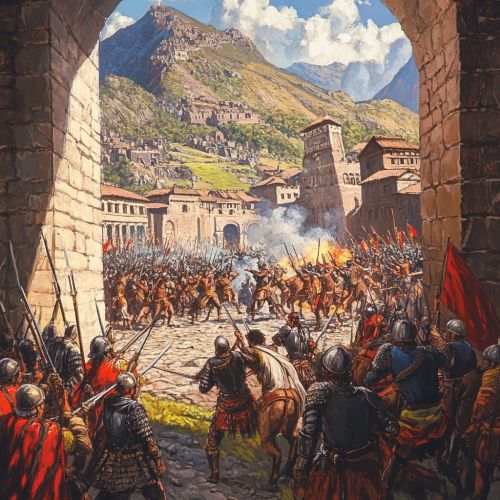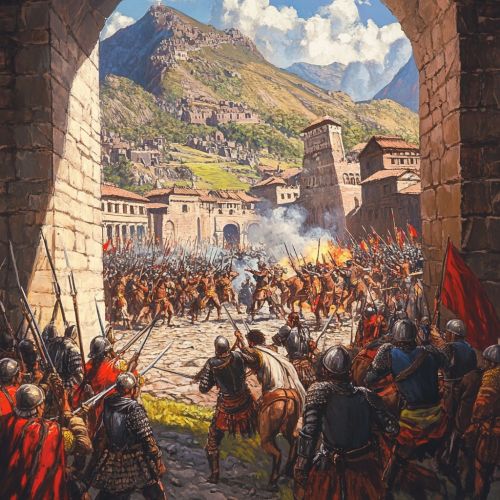Battle of Cuzco: Difference between revisions
(Created page with "== Background == The Battle of Cuzco, fought in 1536, was a pivotal conflict during the Spanish conquest of the Inca Empire. The battle took place in the city of Cuzco, the capital of the Inca Empire, and was a significant event in the broader Spanish conquest of Peru. The conflict was marked by the clash between the Spanish conquistadors, led by Francisco Pizarro, and the Inca forces, commanded by Manco Inca Yupanqui. == Prelude to the Battle == The S...") |
No edit summary |
||
| Line 19: | Line 19: | ||
Manco Inca's forces laid siege to Cuzco, cutting off supply lines and attempting to starve the Spanish into submission. The siege lasted several months, during which both sides suffered significant casualties. The Incas constructed fortifications and used [[sling]]s and [[bows]] to harass the Spanish defenders. | Manco Inca's forces laid siege to Cuzco, cutting off supply lines and attempting to starve the Spanish into submission. The siege lasted several months, during which both sides suffered significant casualties. The Incas constructed fortifications and used [[sling]]s and [[bows]] to harass the Spanish defenders. | ||
[[Image:Detail-97563.jpg|thumb|center|Depiction of the Battle of Cuzco showing Spanish conquistadors fighting Inca warriors in the city of Cuzco.|class=only_on_mobile]] | |||
[[Image:Detail-97564.jpg|thumb|center|Depiction of the Battle of Cuzco showing Spanish conquistadors fighting Inca warriors in the city of Cuzco.|class=only_on_desktop]] | |||
=== Key Engagements === | === Key Engagements === | ||
Latest revision as of 13:50, 10 August 2024
Background
The Battle of Cuzco, fought in 1536, was a pivotal conflict during the Spanish conquest of the Inca Empire. The battle took place in the city of Cuzco, the capital of the Inca Empire, and was a significant event in the broader Spanish conquest of Peru. The conflict was marked by the clash between the Spanish conquistadors, led by Francisco Pizarro, and the Inca forces, commanded by Manco Inca Yupanqui.
Prelude to the Battle
The Spanish conquest of the Inca Empire began in 1532 with the capture of the Inca emperor Atahualpa at the Battle of Cajamarca. Following Atahualpa's execution, the Spanish forces, under the leadership of Francisco Pizarro and his brothers, advanced towards Cuzco. The city was of immense strategic and symbolic importance, being the political, cultural, and religious center of the Inca civilization.
Manco Inca Yupanqui, initially a puppet ruler installed by the Spanish, soon realized the threat posed by the conquistadors to his people and heritage. In 1536, he initiated a large-scale rebellion against the Spanish occupiers, rallying various Inca factions and mobilizing a significant force to reclaim Cuzco.
The Battle
Initial Skirmishes
The battle commenced with a series of skirmishes around the outskirts of Cuzco. The Inca forces employed guerrilla tactics, leveraging their knowledge of the terrain to launch surprise attacks on the Spanish. Despite their numerical superiority, the Incas faced challenges due to the Spanish advantage in firearms and cavalry.
Siege of Cuzco
Manco Inca's forces laid siege to Cuzco, cutting off supply lines and attempting to starve the Spanish into submission. The siege lasted several months, during which both sides suffered significant casualties. The Incas constructed fortifications and used slings and bows to harass the Spanish defenders.


Key Engagements
One of the critical engagements during the battle was the assault on Sacsayhuamán, a formidable Inca fortress overlooking Cuzco. The Spanish, recognizing the strategic importance of the fortress, launched a determined attack to capture it. The fighting at Sacsayhuamán was intense, with both sides displaying remarkable bravery and tenacity.
The turning point came when the Spanish managed to breach the fortress walls, leading to brutal hand-to-hand combat. Despite fierce resistance, the Incas were eventually overwhelmed, and the fortress fell into Spanish hands. The loss of Sacsayhuamán was a significant blow to Manco Inca's forces and marked the beginning of the end for the siege.
Aftermath
The fall of Sacsayhuamán and the eventual lifting of the siege marked a decisive victory for the Spanish. Manco Inca Yupanqui retreated into the mountains, continuing to resist Spanish rule through guerrilla warfare for several more years. However, the Battle of Cuzco effectively solidified Spanish control over the former Inca capital and marked a turning point in the conquest of the Inca Empire.
The Spanish victory at Cuzco had far-reaching consequences. It not only secured their dominance over the region but also facilitated the further expansion of Spanish influence throughout South America. The city of Cuzco itself underwent significant changes, with Spanish architecture and culture gradually supplanting Inca traditions.
Legacy
The Battle of Cuzco is remembered as a critical event in the history of the Spanish conquest of Peru. It exemplifies the clash of two vastly different civilizations and the dramatic impact of European colonization on indigenous cultures. The battle also highlights the resilience and determination of the Inca people in the face of overwhelming odds.
Today, Cuzco remains a city of historical and cultural significance, attracting scholars and tourists alike who seek to understand its rich heritage. The remnants of Inca architecture, such as the walls of Sacsayhuamán, stand as a testament to the city's storied past and the enduring legacy of the Inca civilization.
